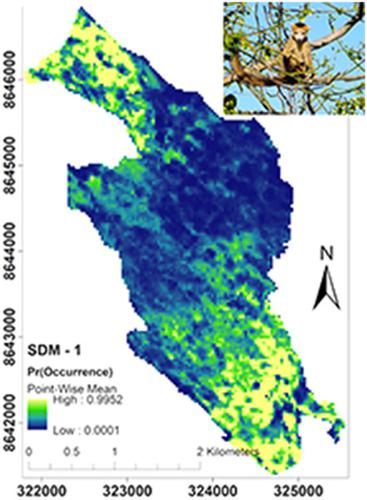当前位置:
X-MOL 学术
›
Am. J. Primatol.
›
论文详情
Our official English website, www.x-mol.net, welcomes your
feedback! (Note: you will need to create a separate account there.)
Realized distribution patterns of crowned lemurs (Eulemur coronatus) within a human-dominated forest fragment in northern Madagascar.
American Journal of Primatology ( IF 2.0 ) Pub Date : 2020-03-23 , DOI: 10.1002/ajp.23125 Fernando Mercado Malabet 1, 2, 3, 4 , Heather Peacock 5 , Jeremi Razafitsalama 6 , Christopher Birkinshaw 7 , Ian Colquhoun 3, 4
American Journal of Primatology ( IF 2.0 ) Pub Date : 2020-03-23 , DOI: 10.1002/ajp.23125 Fernando Mercado Malabet 1, 2, 3, 4 , Heather Peacock 5 , Jeremi Razafitsalama 6 , Christopher Birkinshaw 7 , Ian Colquhoun 3, 4
Affiliation

|
Due to the impact of anthropogenic activities on forest extent and integrity across Madagascar, it is increasingly necessary to assess how endangered lemur populations inhabiting human-dominated forest fragments can effectively sustain themselves ecologically. Our research addresses this concern by exploring how the distribution patterns of a small population of crowned lemurs (Eulemur coronatus), occupying a degraded forest fragment at Oronjia Forest New Protected Area in northern Madagascar, are impacted by the availability of key ecological and anthropogenic factors. We hypothesize that the distribution of E. coronatus within the fragment is limited by the availability of critical ecological resources and conditions and the intensity of anthropogenic features and activities. To examine this, we used MaxEnt to develop a species distribution model using presence-only occurrence records and 10 independent background covariates detailing the site's ecological and anthropogenic aspects. The results indicate that the realized distribution patterns of E. coronatus within human-dominated forest fragments are strongly associated with sections of forest that contain sparsely and sporadically distributed resources, such as freshwater and continuous hardwood vegetation. We conclude that the distribution of E. coronatus at Oronjia is shaped by their need to maximize foraging opportunities in a degraded forest landscape where they are subject to both environmental and anthropogenic stressors.
中文翻译:

在马达加斯加北部人类主导的森林碎片中的冠状狐猴(Eulemur coronatus)的已实现分布模式。
由于人为活动对马达加斯加整个森林的范围和完整性的影响,越来越有必要评估居住在人类主导的森林碎片中的濒危狐猴种群如何有效地自我维持生态。我们的研究通过探索少数马达加斯加北部奥伦加森林新保护区的退化冠状狐猴(小冠狐)的分布方式受到关键生态和人为因素的影响,来解决这一问题。我们假设片段中的冠状大肠杆菌分布受到关键生态资源和条件的可用性以及人为特征和活动强度的限制。为了研究这个 我们使用MaxEnt开发了物种分布模型,该模型使用仅存在事件记录和10个独立的背景协变量来详细描述了该站点的生态和人为因素。结果表明,人类支配的森林碎片中已实现的冠状大肠杆菌分布模式与包含稀疏和零星分布的资源(例如淡水和连续硬木植被)的森林部分密切相关。我们得出的结论是,由于需要最大程度地在退化的森林景观中觅食的机会而影响了Oronjia冠状大肠杆菌的分布,在退化的森林景观中,它们受到环境和人为压力。结果表明,人类支配的森林碎片中已实现的冠状大肠杆菌分布模式与包含稀疏和零星分布的资源(例如淡水和连续硬木植被)的森林部分密切相关。我们得出的结论是,由于需要最大程度地在退化的森林景观中觅食的机会而影响了Oronjia冠状大肠杆菌的分布,在森林环境中,它们既受到环境压力又受到人为压力的影响。结果表明,人类支配的森林碎片中已实现的冠状大肠杆菌分布模式与包含稀疏和零星分布的资源(例如淡水和连续硬木植被)的森林部分密切相关。我们得出的结论是,由于需要最大程度地在退化的森林景观中觅食的机会而影响了Oronjia冠状大肠杆菌的分布,在退化的森林景观中,它们受到环境和人为压力。
更新日期:2020-04-13
中文翻译:

在马达加斯加北部人类主导的森林碎片中的冠状狐猴(Eulemur coronatus)的已实现分布模式。
由于人为活动对马达加斯加整个森林的范围和完整性的影响,越来越有必要评估居住在人类主导的森林碎片中的濒危狐猴种群如何有效地自我维持生态。我们的研究通过探索少数马达加斯加北部奥伦加森林新保护区的退化冠状狐猴(小冠狐)的分布方式受到关键生态和人为因素的影响,来解决这一问题。我们假设片段中的冠状大肠杆菌分布受到关键生态资源和条件的可用性以及人为特征和活动强度的限制。为了研究这个 我们使用MaxEnt开发了物种分布模型,该模型使用仅存在事件记录和10个独立的背景协变量来详细描述了该站点的生态和人为因素。结果表明,人类支配的森林碎片中已实现的冠状大肠杆菌分布模式与包含稀疏和零星分布的资源(例如淡水和连续硬木植被)的森林部分密切相关。我们得出的结论是,由于需要最大程度地在退化的森林景观中觅食的机会而影响了Oronjia冠状大肠杆菌的分布,在退化的森林景观中,它们受到环境和人为压力。结果表明,人类支配的森林碎片中已实现的冠状大肠杆菌分布模式与包含稀疏和零星分布的资源(例如淡水和连续硬木植被)的森林部分密切相关。我们得出的结论是,由于需要最大程度地在退化的森林景观中觅食的机会而影响了Oronjia冠状大肠杆菌的分布,在森林环境中,它们既受到环境压力又受到人为压力的影响。结果表明,人类支配的森林碎片中已实现的冠状大肠杆菌分布模式与包含稀疏和零星分布的资源(例如淡水和连续硬木植被)的森林部分密切相关。我们得出的结论是,由于需要最大程度地在退化的森林景观中觅食的机会而影响了Oronjia冠状大肠杆菌的分布,在退化的森林景观中,它们受到环境和人为压力。











































 京公网安备 11010802027423号
京公网安备 11010802027423号